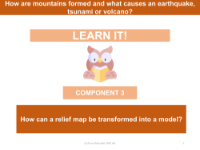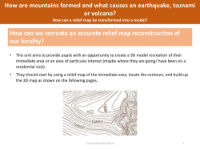How can a relief map be transformed into a model of a mountain? - Teacher notes

Geography Resource Description
Transforming a relief map into a three-dimensional model of a mountain is an intricate task that combines geography with practical skills, offering students a deeper understanding of topographical representation. This challenging unit requires students to apply their disciplinary knowledge to comprehend how two-dimensional maps translate into real-world landscapes. The activity necessitates collaborative work, with pupils ideally forming groups of four to tackle the project effectively, and they may need considerable assistance from the teacher or facilitator throughout the process.
To begin, students should engage with a relief map, preferably of the local area for relevance, or if the locale is predominantly flat, a more varied terrain should be chosen. The key learning objective is for students to become familiar with the concept of 'contour'—the lines on a map that indicate elevation. By identifying and tracing clear contour lines, such as the 50-meter elevation, onto thick card using a coloured pen, students create a tangible representation of each elevation level. After cutting out these tracings and labelling them with the corresponding height, they move on to the next contour line, repeating the process to gradually build up a layered model. This hands-on activity not only solidifies their understanding of relief maps but also provides a visual and tactile experience of how mountains are represented cartographically.



